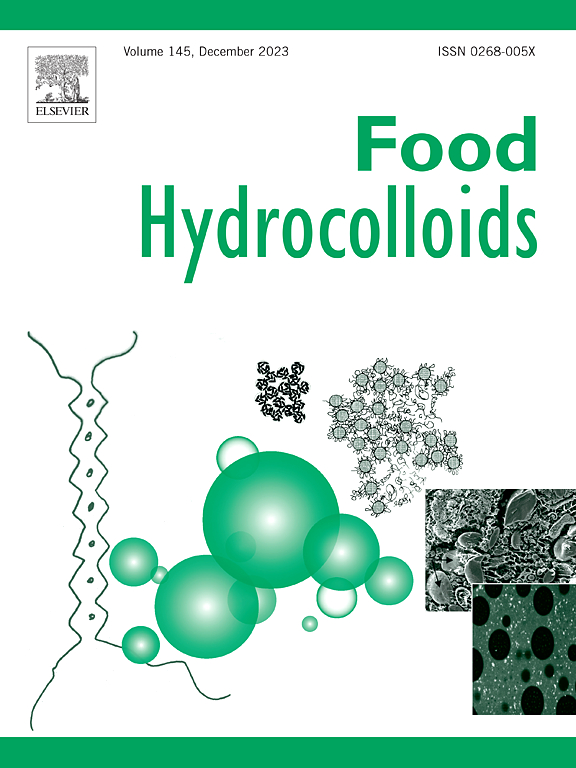Catalytic nucleation effect of the insoluble fraction of Persian gum on amyloid fibrillation of whey protein isolate
IF 11
1区 农林科学
Q1 CHEMISTRY, APPLIED
引用次数: 0
Abstract
Protein nanofibrils are supramolecular structures with unique physicochemical and functional properties that are greatly influenced by their microenvironment during the course of fibrillation. In this study, the formation of amyloid fibrils from whey protein isolate (WPI) was investigated in the presence of the insoluble fraction of Persian gum (IFPG). Whey protein isolate amyloid fibrils, either alone (WPF) or combined with IFPG (WPF + IFPG), were generated by heating the protein solution at 85 °C and pH 2, and their morphological, structural, and functional properties were evaluated. Thioflavin T and Congo Red spectroscopic assays showed that IFPG significantly increased the nucleation rate of the process, resulting in a shortened lag phase. Atomic force microscopy (AFM) and transmission electron microscopy (TEM) also revealed that IFPG led to the formation of more mature and thinner nanofibrils. The results of circular dichroism (CD) spectroscopy confirmed that the secondary structure of the nanofibrils was primarily composed of β-sheet elements, with their composition being significantly influenced by the presence of IFPG and the change in pH. Additionally, SDS-PAGE profiles clearly indicated that the hydrolysates of β-lactoglobulin fraction were the main constituents of WPFs, with non-participating peptides accumulating in the solution. The apparent viscosity and surface activity of the WPF + IFPG sample were significantly higher than those of the WPF solution, which can be attributed to their morphological and structural differences. Furthermore, the presence of IFPG increased the surface hydrophobicity of the fibrils, while decreasing charge density, solubility, and turbidity. The nanofibrils underwent cleavage and aggregation as the pH increased from 2 to 7, resulting in shorter, thicker, and curved morphology. The increase in pH also caused a decrease in surface hydrophobicity and an increase in solution turbidity. These findings demonstrate the catalytic nucleation effect of IFPG particles, which accelerates fibrillation and has the potential to enhance the properties and functionalities of nanofibrils for various applications in the food and pharmaceutical industries.

求助全文
约1分钟内获得全文
求助全文
来源期刊

Food Hydrocolloids
工程技术-食品科技
CiteScore
19.90
自引率
14.00%
发文量
871
审稿时长
37 days
期刊介绍:
Food Hydrocolloids publishes original and innovative research focused on the characterization, functional properties, and applications of hydrocolloid materials used in food products. These hydrocolloids, defined as polysaccharides and proteins of commercial importance, are added to control aspects such as texture, stability, rheology, and sensory properties. The research's primary emphasis should be on the hydrocolloids themselves, with thorough descriptions of their source, nature, and physicochemical characteristics. Manuscripts are expected to clearly outline specific aims and objectives, include a fundamental discussion of research findings at the molecular level, and address the significance of the results. Studies on hydrocolloids in complex formulations should concentrate on their overall properties and mechanisms of action, while simple formulation development studies may not be considered for publication.
The main areas of interest are:
-Chemical and physicochemical characterisation
Thermal properties including glass transitions and conformational changes-
Rheological properties including viscosity, viscoelastic properties and gelation behaviour-
The influence on organoleptic properties-
Interfacial properties including stabilisation of dispersions, emulsions and foams-
Film forming properties with application to edible films and active packaging-
Encapsulation and controlled release of active compounds-
The influence on health including their role as dietary fibre-
Manipulation of hydrocolloid structure and functionality through chemical, biochemical and physical processes-
New hydrocolloids and hydrocolloid sources of commercial potential.
The Journal also publishes Review articles that provide an overview of the latest developments in topics of specific interest to researchers in this field of activity.
 求助内容:
求助内容: 应助结果提醒方式:
应助结果提醒方式:


